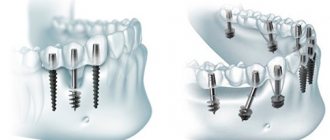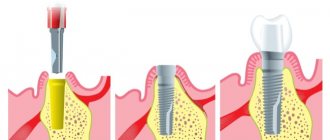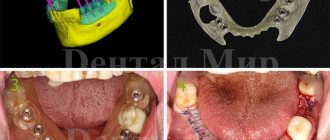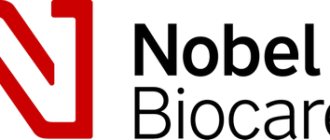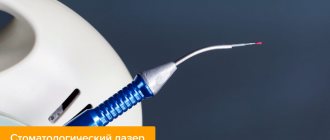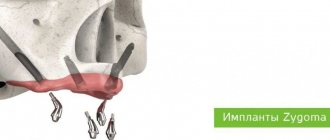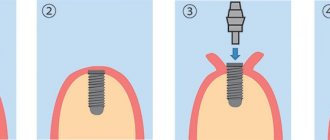This is one of the types of one-stage implantation, which involves inserting an implant into the deep (basal) layer of bone tissue. This feature gave the method its name. The surgical stage of the operation involves the implantation of long, thin metal pins into the jaw. The method was popular because it involves rapid restoration of jaw function, and is also allowed for patients with periodontitis immediately after removal of loose teeth. Characterized by a high risk of implant failure. Currently deprecated.
Page navigation
Why is basal implantation so popular today?
Not all clients are suitable for classical dental implantation due to the banal lack of bone tissue in order to fully implement it. Doctors have to resort to sinus lifting - artificial tissue expansion. However, this process increases not only the time spent on the procedure, but also the cost of the service.
Dental implantation, in addition, can be recommended to almost all people who need it, even those for whom conventional methods are simply not suitable physiologically. Just a few years ago, such patients had no chance. Today, thanks to advances in the medical field, they too will be “saved.” In general, implantation can be avoided if pulpitis and similar diseases are treated in time.
Description of All-on-4/6 implantation
What is remarkable about this technique? The main distinguishing feature is that the installation of the two outer implants is carried out at angles, and the central ones - in a vertical position. In addition, the tops of the implants (abutments) also have angular positions and are called multi-units. The advantage of this design is to minimize the risks of inflammation and loosening during active chewing load.
All-on-4/6 is carried out without incisions in the gums: implants are installed through small punctures. Thus, the gums and bone are not injured, which prevents the development of large swelling in the postoperative period. Reducing the rehabilitation period contributes to a speedy recovery and return to normal life. In addition, All-on-4/6 implantation prevents bone loss due to immediate chewing load almost immediately after the installation of crowns.
When implanting All-on-6, a maximum functional bridge of 12-14 crowns is installed. In some cases, when the volume of bone tissue in the lateral regions is critically low, and also taking into account individual characteristics, we perform implantation on patients using the “all on four” technique. Then the prosthesis will have a shortened appearance of 10 crowns.
Implantation with six units is more reliable in the long term, so we use this technique in most cases.
Current limitations of basal implants
Still, basal implantation has some limitations. If you decide to resort to it, then first familiarize yourself with them. Although, of course, the clinic doctor will tell you about them at your appointment:
- It is impossible to place only one basal implant; at least three are needed. The load on such implants must be distributed evenly, otherwise it will be an inferior replacement for a real tooth and will not be able to fully perform all its functions.
- The period of time that must pass between the moment of installation of the “root” of the implant and its “top” is at least one year. This is exactly how much it will take for everything to take root. And for now you will have to go with a metal frame and a metal-plastic crown. It will be possible to install metal ceramics only after twelve months.
It should also be said that such an operation should only be carried out by a specialist of the highest class; this procedure requires true skill.
And finally, only a good doctor can determine whether this dental implant technology is suitable for a patient. He will be able to understand this from a panoramic photograph of the patient’s jaw.
Today the Republic of Belarus is a leader in the number of dental implants. And our DEC dental clinic is rightfully considered one of the leaders in the field of basal dental implantations in Minsk. Our specialists visit the largest medical centers in Switzerland, Germany and Israel to improve their skills.
Advantages of All-on-4/6 prosthetics
Compared to basal implantation, the All-on-4/6 technique has a number of advantages, including: use in cases of significant bone atrophy in the lateral sections and in the presence of sinusitis (sinusitis). The use of All-on-4/6 does not require a sinus lift, which, accordingly, allows you to save a significant amount.
Also, the installation of implants with multi-units can be performed on patients with significant malocclusions. The technique does not fundamentally correct bite defects, but allows for maximum correction to achieve better aesthetics.
In the case of using the All-on-4 and All-on-6 techniques, all elements of the prosthesis are connected to the implants with screw fixation.
Recommendations for our patients after installation of basal implants
After the basal implants have been installed, each doctor at the DEC dental clinic gives the following recommendations:
- It is necessary within the first ten days, no matter how uncomfortable it may be, to begin loading the installed implants by chewing food. Only then will they begin to take root.
- The implant will take four to six months to take root. During this time, it can “settle” by several millimeters. You should not pay attention to this, especially since this is why metal-plastic rather than metal-ceramic crowns are installed in the first year.
All-on-4/6 implantation at DENTISTRY
DENTISTRY is the only clinic in Belarus that offers All-on-4/6 implantation followed by prosthetics in one day! The clinic has created all the conditions to minimize treatment time without loss of quality.
Before the operation, a joint consultation between the surgeon and the orthopedist is carried out. The day before, they also do professional oral hygiene (even in the case of complete removal of existing teeth). Doctors will explain all the issues related to implantation. You will be given personal recommendations on caring for implants and prostheses, as well as on the procedure to follow in the event of an insured event.
Implantation is carried out in the first or second half of the day. When performing the operation, anesthesia is not required; all manipulations are performed under local anesthesia. The surgeon is guided by computed tomography data and selects the most suitable places to install implants. When applying sutures, absorbable threads are used, and therefore there is no need for an additional procedure to remove the sutures. The final stage is fixation of the finished prosthesis, which we carry out within 24 hours from the end of the surgical operation.
DENTISTRY follows an immediate loading protocol, which means practical use of the denture as soon as possible. For comparison, the standard treatment regimen in other clinics is designed for 5-7 days, which can no longer be considered an immediate burden. Since prosthetics are performed within 24 hours, the discomfort of long waits for finished crowns is eliminated. Our patients have the opportunity to immediately evaluate the functional and aesthetic effects.
The next day after installing the crowns, the orthopedic surgeon conducts a follow-up examination and, if necessary, corrects the prosthesis. Thus, out-of-town and foreign patients do not need a long stay in Minsk. The travel budget is saved: the maximum stay for treatment will be three days.
To summarize: why our clinic does basal implantation in Minsk
Today we can offer our patients this method of implantation, as one of the most effective in several respects:
- It is a one-stage procedure - the operation can be performed immediately after tooth extraction.
- Fast. At the DEC dental clinic, up to twenty implants can be placed in a week, if necessary. When using the classical method, this takes from four to six months.
- Cheap - to carry out a full cycle, fewer surgical interventions are required, and, accordingly, less work for the surgeon. And, as a result, all procedures cost less.
- With this method, the patient’s adaptation to normal life takes virtually no time. Once the implant is installed and the necessary post-procedures are carried out, the person can live as usual
- Suitable for almost everyone - even heavy smokers who are contraindicated for classical implantation.
As for calculating the specific cost of basal dental implantation in Minsk and the price of such an operation, everything is individual. A personal plan for completing all procedures is developed for each client, and depending on the required number of procedures, the total amount that the entire process will cost him is determined.
The entire implantation process is carried out according to protocols approved by the Ministry of Health of the Republic of Belarus.
Advantages and disadvantages of basal implantation
Before you sit in the dentist's chair, you need to carefully study the chosen implantation method and the experience of the doctors you contact. A professional implant surgeon will tell you about all the features, stages and possible complications of the upcoming operation. It must be remembered that any surgical intervention does not go unnoticed by the body and has both advantages and disadvantages.
Advantages:
- Implantation is possible even with complete atrophy of the cancellous bone;
- Implantation has a relatively small number of contraindications;
- In some clinical cases, installation of a permanent prosthesis is possible within 3-4 days after surgery;
- Suitable for older people and heavy smokers.
- The technique belongs to the category of complex operations. The dentist performing the implantation of basal implants must have many years of installation experience and possess the skills of an oral and maxillofacial surgeon;
- High degree of injury and long recovery period (up to 4-6 months);
- High risk of rejection, inflammation and development of peri-implantitis;
- The cost of implantation is quite high, it is on the same level as the classical technique;
- The service is provided by a small number of clinics. Therefore, if you decide to undergo basal implantation, there is still a chance that you will end up with the “wrong” dental implantologist.
Flaws:
What implants do we use?
To carry out All-on-4/6, DENTISTRY uses more than one implant system. This is due to the fact that there is no unified brand in the world that would cover solutions for all possible clinical cases. In general, certain implant systems are great for addressing issues in the anterior jaw, while others are great for addressing bone atrophy issues in the posterior jaw. Implants also differ in surface design, titanium purity and other characteristics.
Currently in our practice we use the following brands of implants: - Noris (Israel); — Megagen (Korea); — OSSTEM (Korea); — Straumann (Switzerland); — Nobel Biocare (Sweden).
Our distinctive characteristic is also that we use the concept of “implant friendship”, when it is possible to use implants of brand A and brand B together to solve the individual situation of the patient. Thus, we do not tailor the capabilities of any one implant system to the patient, but use the combination of the strengths of different brands to achieve maximum results.
Modern types of dental implantation
Today, there are several options for dental implantation, the most common and popular among which are classic and basal. In order to choose the optimal implantation option that best suits a person, it is worth knowing about their features, advantages and disadvantages.
Classic implantation
It consists of two stages, between which 3-6 months pass (two-stage implantation). The first stage of the procedure is the installation of a neutral metal implant into the gum bone tissue, which takes root in the bone tissue within several months (the period depends on the individual characteristics of the body). After a certain time, the dentist makes an incision over the implant and fixes the abutment on it or forms the gum. After this, it is possible to install a temporary crown (usually metal-plastic), which is not recommended to be subjected to heavy loads. After two weeks (provided there are no difficulties), the production of permanent crowns and their installation begins.
Basal implantation
The dentition is restored without building up bone tissue. This procedure consists of implanting implants into the basal bone, the shape and size of which are ideally selected taking into account the anatomical features of the jaw and dentition. Visually, basal implants look like an inverted letter “T” and they are made of alloys based on titanium, aluminum, and vanadium. The implant is screwed into the jaw bone, where, thanks to the use of special metals, it fuses with it, so it can become a full-fledged tooth replacement. It is worth noting that with this type of implantation, the chewing load is distributed evenly, and after healing the patient will not experience discomfort. After the implant has taken root, an abutment is installed on it, and then a crown or bridge.
Preparation for implantation
Planning for implantation and prosthetics begins with a face-to-face consultation with an orthopedic dentist and/or surgeon. Our consultations last up to 45-60 minutes. During the consultation, doctors will listen to your problems and explain in detail all the nuances of implantation.
The consultation begins with a detailed analysis of computed tomography, which will allow you to select the appropriate brand and size of implants and plan the need for additional services (for example, PRF lifting, gum grafting or alveolar splitting). The safest places to install implants are also determined. Based on the image, a model of a surgical template is created to visualize the expected result.
After the consultation, our administrators finalize the treatment plan indicating the cost.
If you do not live in Minsk or outside Belarus, then to draw up a preliminary treatment plan it is enough to send us a computed tomography scan. Within 1-2 business days you will be provided with a conclusion with a cost estimate.
Before implantation, it is necessary to undergo a mandatory medical examination, the results of which will confirm the absence of absolute and relative contraindications. You can find a list of tests here.
The entire list of tests can be taken at your place of residence or in Minsk at a partner laboratory. As a pleasant bonus, you will be given a discount on testing.

